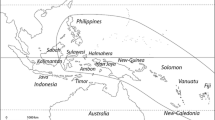Summary
Under different light regimes, Desmodium canum (Gmel.) Schin. & Thell. responded as a long-day plant, D. intortum (Mill.) Urb. and D. uncinatum (Jacq.) dc. as short-day plants, and D. sandwicense E. Mey. as photoperiod-insensitive. Tripping method with anther removal, washing of stigmas and pollen transfer was simple and less time-consuming, gave an equal number of hybrids but more selfed progenies than the tedious method of emasculating prior to anthesis. A high percentage of selfing indicated that the four species are self-compatable and that foreign pollen did not show advantage over that from the same plant. Silver marking of the leaflet midrib of D. sandwicense and D. uncinatum in crosses with D. intortum was a useful dominant marker, but did not appear in the cross D. canum × D. uncinatum. Brown flecking of D. intortum leaflet was a dominant characteristic and occurred on the progenies from crosses with D. sandwicense and D. uncinatum along with the silver marking. Stem growth habit, leaflet form, and pubescence were helpful but less reliable for identifying hybrids. F1 hybrids were readily verified by isozyme patterns of esterase and peroxidase, the zymograms having common and different bands of the parents.
Similar content being viewed by others
References
Alarcon, M. E., 1971. Variation in digestibility among and within Desmodium spp. M.Sc. thesis, Cornell University, pp. 91.
Bingham, E. T. & K. J. Yeh, 1971. Electrophoretic patterns among alfalfa seed proteins from selected varieties, experimental stocks and species accessions. Crop Sci. 11: 58–61.
Bryan, W. W., 1969. Desmodium intortum and Desmodium uncinatum. Herbage Abstr. 39 (No 3); 183–191.
Desborough, S. & S. J. Peloquin, 1968. Potato variety identification by use of electrophoretic patterns of tuber proteins and enzymes. Am. Potato J. 45: 220–229.
Frankel, T. N., & E. D. Garber, 1965. Esterase extracts from germinating seeds of twelve pea varieties. Bot. Gaz. 126: 221–222.
Hosaka, E. K., 1945. Kaimi Spanish clover (Desmodium canum) for humid lowland pastures of Hawaii. Hawaii agric. Exp. Stn. Circ. 22, pp. 10.
Hutton, E. M., 1960. Flowering and pollination in Indigofera spicata, Phaseolus lathyroides, Desmodium uncinatum and several other tropical pasture legumes. Emp. J. exp. Agric. 28: 117–125.
Hutton, E. M. & S. G. Gray, 1967. Hybridization between the legumes Desmodium intortum, D. uncinatum and D. sandwicense, J. Aust. Inst. agric. Sci. 33: 122–123.
McWhirter, K. S. 1963. A. Rep. CSIRO Div. trop. Pastures 1962–63: 32.
McWhirter, K. S., 1969. Cytoplasmic male sterility in Desmodium. Aust. J. agric. Res. 20: 227–241.
Rotar, P. P. & K. H. Chow, 1971. Morphological variation and interspecific hybridization among Desmodium intortum, Desmodium sandwicense, and Desmodium uncinatum. Tech. Bull. No 82, Hawaii agric. Exp. Stn. pp. 28.
Verdcourt, B. 1970. Studies in the Leguminosae Papilionidae for the ‘Flora of Tropical East Africa’. IV. Kew Bull. 24: 507–569.
Author information
Authors and Affiliations
Additional information
Plant Breeding Paper No 639.
Rights and permissions
About this article
Cite this article
Chow, K.H., Crowder, L.V. Hybridization of Desmodium species. Euphytica 22, 399–404 (1973). https://doi.org/10.1007/BF00022653
Received:
Issue Date:
DOI: https://doi.org/10.1007/BF00022653



